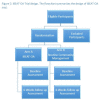Evaluating the efficacy of Internet-Based Exercise programme Aimed at Treating knee Osteoarthritis (iBEAT-OA) in the community: a study protocol for a randomised controlled trial
- PMID: 31662373
- PMCID: PMC6830654
- DOI: 10.1136/bmjopen-2019-030564
Evaluating the efficacy of Internet-Based Exercise programme Aimed at Treating knee Osteoarthritis (iBEAT-OA) in the community: a study protocol for a randomised controlled trial
Abstract
Introduction: Knee osteoarthritis (OA) is the most common joint disease worldwide. As of today, there are no disease-modifying drugs, but there is evidence that muscle strengthening exercises can substantially reduce pain and improve function in this disorder, and one very well tested physiotherapy protocol is the 'Better Management of Patients with Osteoarthritis' developed in Sweden. Given the high prevalence of knee OA, a potentially cost-effective, digitally delivered approach to treat knee OA should be trialled. This study aims to explore the benefits of iBEAT-OA (Internet-Based Exercise programme Aimed at Treating knee Osteoarthritis) in modulating pain, function and other health-related outcomes in individuals with knee OA.
Methods and analysis: A randomised controlled trial was designed to evaluate the efficacy of a web-based exercise programme in a population with knee OA compared with standard community care provided by general practitioners (GPs) in the UK. We anticipate recruiting participants into equal groups. The intervention group (n=67) will exercise for 20-30 min daily for six consecutive weeks, whereas the control group (n=67) will follow GP-recommended routine care. The participants will be assessed using a Numerical Rating Scale, the Western Ontario and McMaster Universities Osteoarthritis Index, the Arthritis Research UK Musculoskeletal Health Questionnaire, the Pittsburgh Sleep Quality Index, 30 s sit to stand test, timed up and go test, quantitative sensory testing, musculoskeletal ultrasound scan, muscle thickness assessment of the vastus lateralis, and quadriceps muscles force generation during an isokinetic maximum voluntary contraction (MVC). Samples of urine, blood, faeces and synovial fluid will be collected to establish biomarkers associated with changes in pain and sleep patterns in individuals affected with knee OA. Standard parametric regression methods will be used for statistical analysis.
Ethics and dissemination: Ethical approval was obtained from the Research Ethics Committee (ref: 18/EM/0154) and the Health Research Authority (protocol no: 18021). The study was registered in June 2018. The results of the trial will be submitted for publication in a peer-reviewed journal.
Trial registration number: NCT03545048.
Keywords: iBEAT-OA; knee osteoarthritis; knee pain; web based intervention.
© Author(s) (or their employer(s)) 2019. Re-use permitted under CC BY. Published by BMJ.
Conflict of interest statement
Competing interests: None declared.
Figures



References
-
- Royal College of General P, McCormick A, Fleming D, Charlton J, Great B, Office of Population C, et al. Morbidity statistics from general practice: fourth national study 1991-1992. London: H.M.S.O 1995.
-
- Conaghan PG, Dickson J, Grant RL. Care and management of osteoarthritis in adults: summary of NICE guidance. BMJ 2008;336:502–3. 10.1136/bmj.39490.608009.AD - DOI - PMC - PubMed
Publication types
MeSH terms
Associated data
LinkOut - more resources
Full Text Sources
Medical
Research Materials
